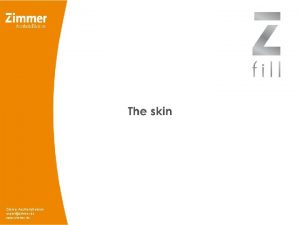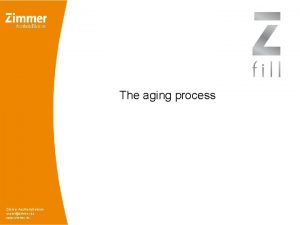Zimmer Aesthetic Division exportzimmer de www zimmer de











- Slides: 11

Zimmer Aesthetic. Division export@zimmer. de www. zimmer. de

The human skin The skin is a soft outer covering and the largest organ of the system that protects the body from damage. It guards the underlying muscles, bones, ligaments and internal organs. Because it interfaces with the environment, the skin plays a key role in protecting the body against pathogens and excessive water loss. Other functions: insulation, temperature regulation, sensation, and protection of vitamin B folates. Severely damaged skin will try to heal by forming scar tissue (often discolored and depigmented). Zimmer Aesthetic. Division export@zimmer. de www. zimmer. de

The skin represents: 3, 5 to 4, 5 kg (of an adult’s weight) Up to 2 m² 1, 5 to 4 mm thickness depending on the area of the body (the sole of the feet and the palms of the hands have much thicker layers) Zimmer Aesthetic. Division export@zimmer. de www. zimmer. de

The skin has 3 main layers: Epidermis (E) (protects the body, lazer in which cell renewal takes place) Dermis (F) Subdermis(G) (fatty tissue that cushions and supports the 2 upper layers of the skin) Zimmer Aesthetic. Division export@zimmer. de www. zimmer. de

The epidermis is the thin outer layer of the skin. The epidermis itself is made up of three sub-layers: the stratum corneum (top layer), keratinocytes and basal layer. The top layer contains dead keratinocytes. The keratin, a protein formed from the dead cells, protects the skin from harmful substances. As the keratinocytes mature, they move towards the top layer and die on the surface. This is how the epidermis is renewed every 25 to 40 days. Zimmer Aesthetic. Division export@zimmer. de www. zimmer. de

The keratinocytes layer contains living keratinocytes. The inner layer of the epidermis contains basal cells. They continually divide, forming new keratinocytes and replacing the old ones. The epidermis also contains melanocytes, which are cells that produce melanin (skin pigment), its distribution being the main reason for the variations in skin color. The keratinocytes layer contains living keratinocytes. The inner layer of the epidermis contains basal cells. They continually divide, forming new keratinocytes and replacing the old ones. Zimmer Aesthetic. Division export@zimmer. de www. zimmer. de

The dermis is the middle layer (connective tissue) of the skin and is made up of the following: blood vessels lymph vessels hair follicles sweat glands The dermis is held together by a protein called collagen, made by fibroblasts (skin cells that give the skin its strength and resilience). Elastin and HA are contained in the dermis. This layer also contains pain and touch receptors. Zimmer Aesthetic. Division export@zimmer. de www. zimmer. de

The subdermis is the deepest layer of skin and is also known as the subcutaneous layer. Consisting of a network of collagen and fat cells, it helps conserve the body's heat while protecting other organs from injury by acting as a "shock absorber. " Zimmer Aesthetic. Division export@zimmer. de www. zimmer. de

Collagen : a protein (25% of total amount) that connects and supports bodily tissues, such as skin, bone, tendons, muscles, and cartilage. It is like a glue that holds the body together. It gives body tissues form and provides firmness and strength. As people age, however, collagen degradation occurs, leading to wrinkles. Elastin: is a protein that helps to keep skin flexible but tight. Enough elastin in the skin means that the skin will return to its normal shape after a pull. It also helps keep skin smooth as it stretches to accommodate normal activities. Elastin tends to deplete as people age, resulting in wrinkled or stretched out skin. Fibroblasts: are the most common cells of connective tissue. They synthesize the extracellular matrix and collagen, and play a critical role in wound healing. Zimmer Aesthetic. Division export@zimmer. de www. zimmer. de

Keratin : is a strong protein and a major component in skin, hair, nails and teeth. Keratin is formed by keratinocytes. The cells slowly push their way upwards, eventually dying and forming a protective layer of cells. Thousands of these cells are shed every day, and the process can be accelerated by various medical conditions, such as psoriasis. Melanin: is a class of compounds found in plants and animals where it serves predominantly as a pigment. It is an excellent photoprotectant. It absorbs harmful UVradiations. This property enables melanin to dissipate more than 99. 9% of the absorbed UV radiation as heat and it keeps the generation of free radicals at a minimum. Hyaluronic acid: is a glycosaminoglycan distributed widely throughout connective, epithelial and neural tissues. Hyaluronan is an important component of articular cartilage, where it is present as a coat around each cell. Hyaluronan is also a major component of the skin, where it is involved in tissue repair. Zimmer Aesthetic. Division export@zimmer. de www. zimmer. de

Thank you very much for your attention! Zimmer Aesthetic. Division export@zimmer. de www. zimmer. de





















